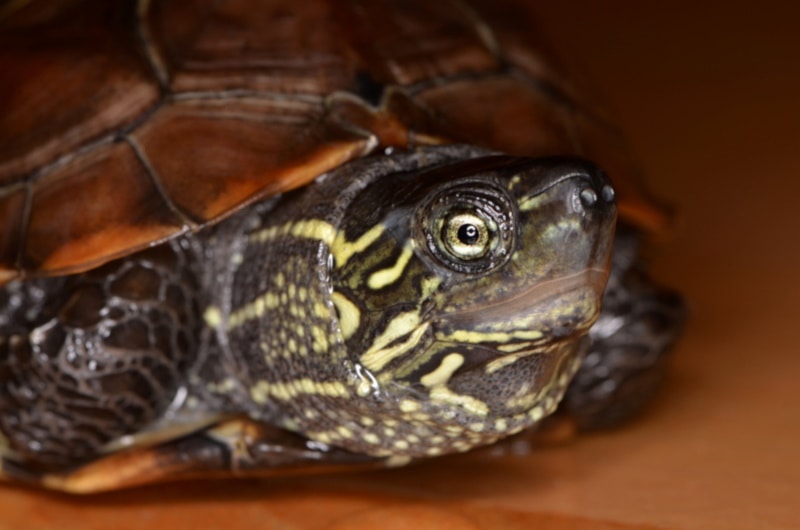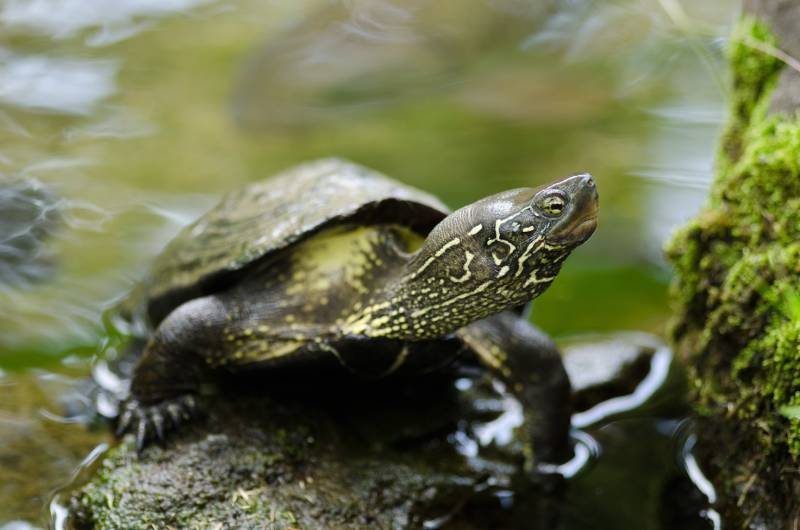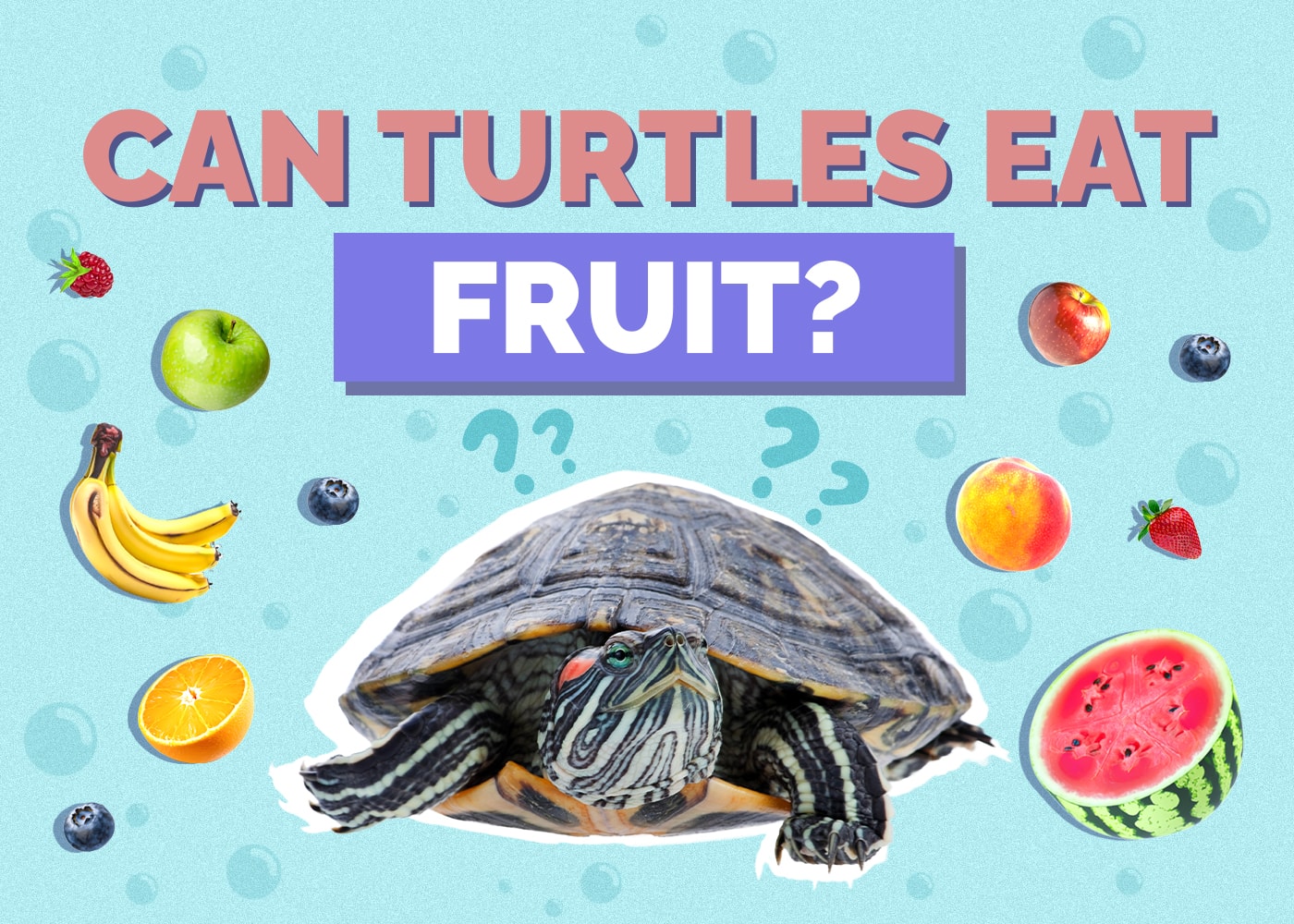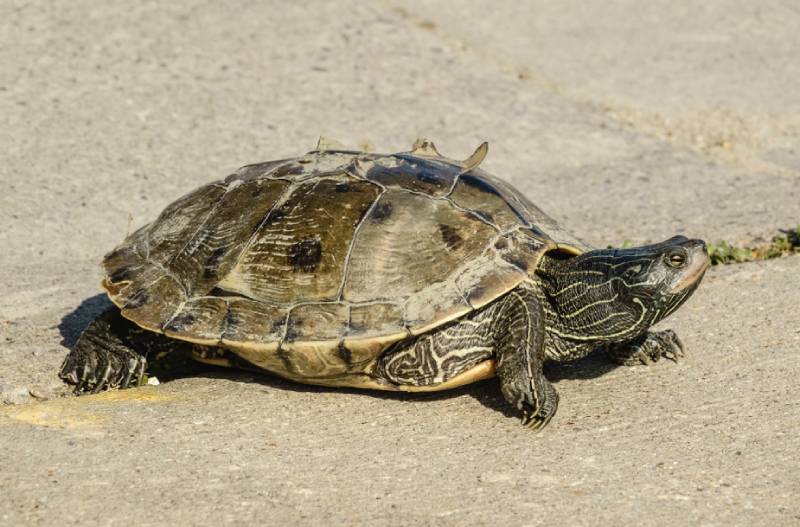Reeve’s Turtle (Chinese Pond Turtle): Pictures, Facts, Diet & Care Guide
Updated on

Reeve’s turtle, Chinese pond turtle, or Chinese three-keeled pond turtle are different names for the same species: Mauremys reevesii. These turtles get their name from the presence of three keels on their carapace. They are native to Korea and subtropical China. Reeve’s turtle populations are also found in Japan, Hong Kong, and Taiwan.
| Size: | Miniature |
| Weight: | 0.4 – 1.1 pounds |
| Lifespan: | 10 – 24 years |
| Suitable for: | Owners who need a small and solitary turtle |
| Temperament: | Shy, active, peaceful |
Reeve’s turtles are semi-aquatic, living on both water and land. During the day, they come out to bask in the sun and are often found on logs and rocks. The water bodies they prefer include shallow ponds, canals, streams, and marshes.
Reeve’s turtles are known for their hybridization abilities. They can mate with distantly related species in the family (Geoemydidae) too. Some species that the Reeve’s turtle has hybridized with include the four-eyed turtle, Japanese pond turtle, Malayan box turtle, and Chinese stripe-necked turtle.
If you already own other members of the Geoemydidae family, you should keep your Chinese pond turtle in a different tank.
Reeve’s Turtle (Chinese Pond Turtle) Characteristics
How Much Do These Turtles Cost?

A Reeve’s turtle will cost you anywhere from $45 to $80, depending on where you buy it. There’s no shortage of Chinese pond turtles since they are farmed extensively for the pet trade and Shang divination rites.
Data from 2002 shows that turtle farmers sold nearly 565,800 Reeve’s turtles per year, bringing an estimated revenue of over $6 million. Interestingly, not all turtle farmers responded to this survey. So, the actual amount is definitely higher.
The data indicates you won’t have trouble finding a Reeve’s turtle to keep as a pet. However, easy availability doesn’t necessarily mean zero friction in the purchase process.
Since turtles may transmit Salmonella, the Centers for Disease Control and Prevention (CDC) recommends not getting small turtles if you have kids under five, elderly, or immunocompromised individuals at home. Due to the risk of Salmonella transmission, some US states also require permits for turtle ownership. Therefore, you must check the regulations in your state before you start shopping for a Chinese pond turtle.
Reeve’s Turtle (Chinese Pond Turtle) Behavior
Chinese pond turtles are generally shy but active. You’ll find them basking on the rocks in their tanks for the most part of the day.
Do These Turtles Make Good Pets?
Reeve’s turtles make good pets if you’re not a pet owner who likes to coddle or handle their pets too much. These turtles don’t fancy excessive handling. They may try to escape or bite your hand if you hold them for too long. Since they can also scratch your skin, it’s best not to keep them as pets if you have young and curious kids at home.

Reeve’s Turtle (Chinese Pond Turtle) Breed Tank Mates
Whether you choose to give your Reeve’s turtle tank mates or not will depend on the size of the tank. If you have a smaller tank, your Chinese pond turtle will not like to share it with another turtle.
Reeve’s turtles are territorial and may fight with other turtles who try to inhabit their space. Multiple turtles can co-exist in a large tank, provided they have separate basking spots.
Even then, make sure the other turtles do not belong to the same family as the Chinese pond turtle since there’s a risk of hybridization. If you’re a first-time or relatively inexperienced turtle owner, stick to the no tank mates rule.
Care Sheet & Habitat Setup: Reeve’s Turtle (Chinese Pond Turtle)
Turtles need a sizable tank with the right temperature, lighting, substrate, and filtration system to thrive. Keep the following requirements in mind for your Reeve’s turtle.
Light Requirements
Turtles need a vitamin D source for calcium metabolism or breakdown. You can provide this vitamin to your Reeve’s turtle through UVA/UVB lighting. UV lighting may not be necessary if your turtle gets vitamin D from food sources.
If the tank needs a UV light, keep it close to the basking area. There should be a distance of about 12 to 15 inches between the light and the tank’s floor.
Besides UV lighting, there should be a heat-emitting light above the basking area in the tank. Fluorescent or incandescent lighting is suitable for extra illumination if required.
To create a day/night cycle in the tank, you can use a timer or dimmer switch to control the lighting. Adjust the cycle length based on the season.
If you keep your Reeve’s turtle outdoors, the sun’s illumination and heat will suffice.

Tank Size
Turtles, irrespective of the species, need a lot of room to roam around. Even smaller breeds like Reeve’s turtles need an enclosure of about 29 gallons. It should be 18 inches in width and 4 feet long.
Due to the high adaptability of Chinese pond turtles, you can house this species in any kind of tank as long as it’s the right size. Some options include glass aquariums and stock tanks. These turtles can also live in garden ponds outdoors. Make sure you have proper escape prevention and predator protection measures in place to avoid safety concerns.
Water Temperature
There should be a temperature gradient between the air, basking area, and water temperatures. Maintain the water temperature between 70°F to 80°F. The ambient air temperature should be about five degrees higher at 75°F or 85°F, whereas the basking area temperature must be the highest at 85°F to 95°F.
When determining the enclosure’s temperature, do not rely on your room’s thermostat. A turtle’s body produces heat too, which can change the internal temperature of a tank. Check the tank’s temperature periodically to ensure it’s in the right range.
Plants
If you want, you can put some non-toxic plants in your Chinese pond turtle’s tank. These plants serve as hiding spots for turtles.
However, these turtles have an affinity for shredding plants even if they don’t eat them. You might find plastic plants to be more long-lasting.

Substrate
Adding a substrate to the bottom of the tank is not necessary, but you can add gravel or sand if you want. The substrate size should be so big that the turtle cannot swallow it or so small that it passes through their digestive system easily.
Good examples of such substrates are riverbed sand or large pebbles. Clean the substrate before you put it in the enclosure, and let it set before you put the turtle in and activate the equipment.
Filtration
Since Reeve’s turtles like to spend time in the water, you must keep the water source clean. The high-protein diet of this species means the filter must be strong enough to remove excess food and waste.
A good filter will need to be cleaned twice a month. You should also clean the whole tank every one or two months.
Buy a filter that can clean a tank twice as big as yours. Also, get a siphon device or a vacuum to replace half the water in the tank with fresh water every week. You can also add a bubbler to add air bubbles and enhance the quality of water.
Besides filtration, you should also treat the water before adding it to the tank the first time. Otherwise, the water’s trace elements can disrupt the turtle’s habitat.
Things to Know When Owning a Reeve’s Turtle (Chinese Pond Turtle)
Food & Diet Requirements

Reeve’s turtles can eat meat, live food, and aquatic food. If you cannot find fresh options, you can also serve your pet with dried foods, such as shrimp. These turtles readily feed on brown crickets. Other meat food options include dubia cockroaches, black crickets, locusts, chicks, mice, salmon, and shrimp.
In addition to protein content, you can also feed your pet leafy greens or aquatic plants, like duckweed and water hyacinth. Foods containing vitamin D are also a good addition to a Chinese pond turtle’s diet since they facilitate calcium breakdown.
Size & Growth Chart
Reeve’s turtles are small in size, only a few centimeters at birth. At maturity, males are about 4.5 to 6 inches in length, while females are bigger at 4.5 to 9 inches.
These turtles grow slowly in their early years and reach maturity a bit late. Male Reeve’s turtles can mate at 4 years of age, while females are sexually mature when 7 years old.
Lifespan and Health Conditions
Chinese pond turtles can live for about two decades in captivity. Although not all Reeve’s turtles will be such long-term companions, you can expect most of them to live for 10 to 15 years.
The species is generally healthy but may fall prey to several health conditions. Some of them are more serious than others.
Serious Conditions
Cystic calculi, also called bladder stones, is a common turtle health concern. If your pet is not properly hydrated or isn’t getting the right diet, the minerals in their diet can result in crystal formation in the urine. These crystals join to form stones.
Blood in turtle droppings is a major sign of bladder stones. The condition is diagnosed with a physical exam and X-rays. Stone removal involves fluid therapy and surgery.
Minor Conditions
Shell fractures and irregular shell growth may point towards poor nutrition or physical trauma. Your turtle may have an asymmetrical or soft shell that doesn’t provide them the necessary protection.
Immediate medical intervention is necessary to ensure proper treatment and corrective action.
 Male vs Female
Male vs Female
Since there are no differences in the physical appearances of male and female Reeve’s turtles, you cannot tell your pet’s sex upon hatching or at a young age. It’s easier to distinguish between sexes as they grow.
The main difference between males and females is the size. Unlike many other animal species, female Chinese pond turtles grow larger than their male counterparts.
3 Little-Known Facts About Reeve’s Turtle (Chinese Pond Turtle)
1. Reeve’s Turtles May Breed Without Encouragement
If you house a male and female Chinese pond turtle in the same enclosure, they may breed without any encouragement from your side. All they need are good breeding conditions and a healthy diet.
2. Mercury Vapor Bulbs Are Good Additions to Turtle Enclosures
If you want a single source for both UV and heat, opt for a mercury vapor bulb. Keep it about 30 centimeters from the turtle’s basking spot. A ceramic or porcelain lamp holder will keep the bulb in place.
3. Reeve’s Turtles Go Right in the Pond
Since staying in the enclosure does not harm the Chinese pond turtle, you can keep your pet in a tank from the beginning of their life. They can remain in a tank their whole lives healthily.

Conclusion
A Chinese pond turtle will make a good pet for you if you need a pet that you don’t have to pay too much attention to. However, before you get a Reeve’s turtle, remember that they live for quite a long time. You should be prepared for long-term companionship and care. Also, if you have children at home, avoid getting a small turtle.
If you think you cannot care for them any longer, get in touch with a turtle society or rescue organization. Do not release your pet out in the wild since they may threaten your area’s native turtle population.
Featured Image Credit: Marek Velechovsky, Shutterstock












